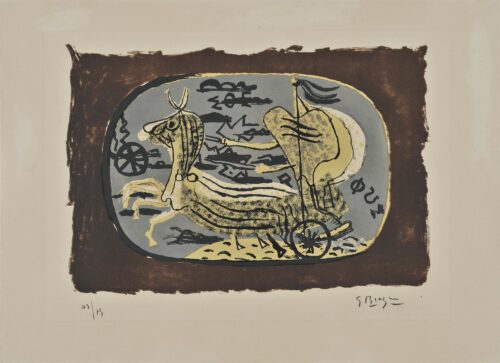
Braque Georges (1882 - 1963)
Phaethon, 1945
He began his study of art in La Harve in the Municipal Art School from which he graduated. There he met Othon Friesz and Raoul Dufy and he kept up his friendship with them when he settled in Paris in 1902. He got to know the work of Van Gogh and took lessons at the Academie Humbert, where Francis Picabia and Marie Laurencin were among his fellow students. For a brief time in 1903 he attended the Leon Bonnat Studio at the Ecole de Beaux Arts from which Friesz and Dufy had already graduated. The strictly academic teachings of Bonnat did not suit the nature of his inquiries and he soon left his studies there.
He came into contact with avant garde art of the time in 1905, when he visited the Salon d’ Automne and saw the works of Derain and Matisse. He also got to know the members of the “Cercle de l’ Art Moderne”. He exhibited for the first time in 1906 at the Salon des Independants and this was followed by works influenced by the Fauvists. Apollinaire introduced him to Picasso. He also got to know the gallery owner Daniel-Henry Kahnweiller. He travelled to Estaque and gradually abandoned Fauvist color while at the same time coming under the influence of Cezanne’s work. In 1907 he saw “Les Demoiselles d’ Avignon” in Picasso’s workshop and impressed by it, painted his own “Large Nude”. The organization of the volumes and the use of color reveal its relationship to Picasso’s work. He painted his first cubist works in 1908, after another trip to Estaque, and then exhibited them in Kahnweiller’s gallery.
These would be followed by the still lifes concerned with musical instruments which launched the period of analytical cubism. Until 1912, he did experiments with the use of letters of the alphabet in his work and mixing sand in his pigments. During this period he met with Picasso daily. Both of the artists began to use various non-painting materials in their works arriving at works combining collage and painting. Their experiments would continue until 1914 when Braque was called up to serve in the French Army. He received a serious head injury that left him blind for a long period. He became involved with painting again after 1916 and until 1918 would continue to work in the spirit of analytical Cubism. During the following years the dimensions of his works would grow and for the first time he became interested in engraving.
In the middle of that decade he would adopt a neoclassical style in reply to the chaos the war had created. He would also become involved with stage and costume design, working with the Ballet Russes. In 19129 he built a country house in the village Varengeville-sur-Mer in Normandy. He spent his summers there and produced small landscapes. The motif of repeated curved outlines would lead him to the study of ancient Greek vases at the Louvre. In 1932 he illustrated Hesiod’s “Theogony”, commissioned by Ambroise Vollard. His color gamut gradually changed. He began a series of works whose subject was his studio and “Vanitas”.
During the Occupation the painter spent a period of inactivity and then painted the interiors of houses, or did still lifes in dark colors. After the Liberation, he returned to Varengeville and a while later became involved with color lithography. By 1956 he had completed nine series of works with his studio as the subject. In 1953 he was invited to decorate the ceiling of the Etruscan room at the Louvre. His final works were landscapes of small dimensions done in sharp relief with a tendency toward abstraction.
Creator, together with Picasso, of Cubism, he influenced all later European art through his experiments.

Phaethon, 1945

We use cookies to make our site work properly, to personalize content and ads, to provide social media features and to analyze our traffic. We also share information about how you use our site with our social media, advertising and analytics partners. Read the Cookies Policy.
These cookies are necessary for the website to function and cannot be switched off in our systems. They are usually only set in response to actions made by you which amount to a request for services, such as setting your privacy preferences, logging in or filling in forms. You can set your browser to block or alert you about these cookies, but some parts of the site will not then work. These cookies do not store any personally identifiable information.
If you disable this cookie, we will not be able to save your preferences. This means that every time you visit this website you will need to enable or disable cookies again.
These cookies tell us about how you use the site and they help us to make it better. For example these cookies count the number of visitors to our website and see how visitors move around when they are using it. This helps us to improve the way our site works, for example, by ensuring that users find what they are looking for easily. Our website uses Google Analytics for statistics reporting.
Please enable Strictly Necessary Cookies first so that we can save your preferences!